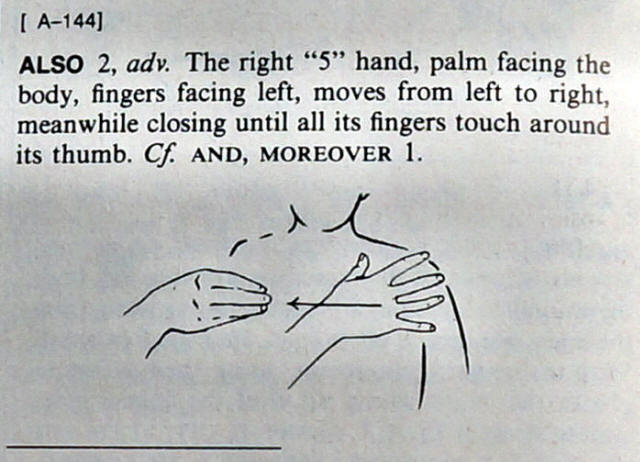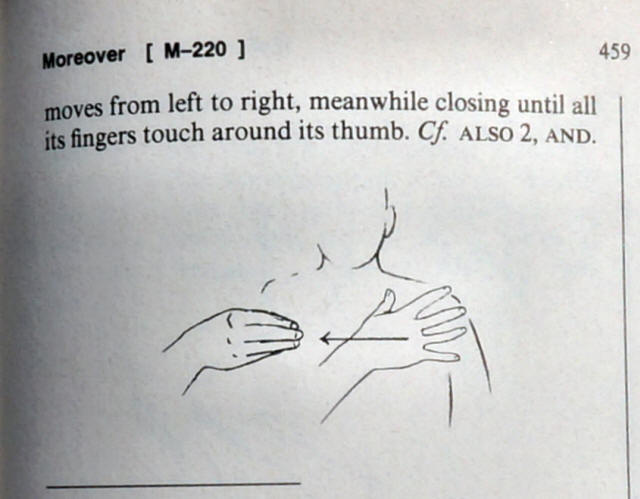American Sign Language: "AND"
-- advanced
Most of the time, we don't sign need to sign the word AND because it's implied by grouping the objects together.
For example:
A. It's not needed when listing a group of objects in a row.
FOR BREAKFAST I ORDER PANCAKE, EGG, COFFEE.
I PREFER COLORS BLUE, YELLOW, GREEN
B. Nor is it needed when using common word pairs:
RECENTLY I WATCH MOVIE BLACK WHITE
MOM DAD LEFT YESTERDAY.
WHERE SALT PEPPER?
CHICKEN I LIKE SWEET SOUR.
C. And quite often, the concept of AND is indicated through head or body shifting, in the same way we do for OR. Except, I tend to do it with a slight shift of the head between signed objects, rather than a prominent shift of the head or shoulder/body.
I WORK MONDAY (shift) FRIDAY
I HAVE TWO CHILDREN BOY (shift) GIRL
So, when should we use the sign AND?
The sign AND is generally used to create an emphasis to the last additional item.
A good rule of thumb is to substitute the word AND with the ASL sign for PLUS. If the sentence still makes sense (in ASL) -- then it's okay to use the sign AND. For example, HORSE PLUS CAT
I WANT HORSE AND CAT
BREAKFAST, I PREFER MILK AND ORANGE JUICE
I PREFER SCIENCE AND ENGLISH
RECENTLY I WORE WHITE AND BLACK
MY PARENTS SKILLED ENGLISH, ASL AND SPANISH.
THIS SEMESTER I TAKE UP BIOLOGY, CALCULUS, AND PHYSICS
AND can also be used:
A. To add to or expound upon a previous comment, whether your own or someone else's
HUSBAND: WE HAVE 3 KIDS.
WIFE: AND TWO DOGS!
B. To connect two true statements
SWIMMING ALONE FORBIDDEN. AND, DANGEROUS.
ENTIRE BOOK AWFUL! AND, MOST INACCURATE.
YESETRDAY MY CHIDLREN SHOW UP LATE AND THEY DIDN'T DO THEIR CHORES
C. As an ASL substitute for MOREOVER, FURTHERMORE, ADDITIONALLY, ALONG WITH, et cetera.
Swimming alone is against the rules. And moreover, it's dangerous.
That book was poorly written. Not only that, it was mostly
inaccurate.
Notes:
Over at H a n d s p e a k.com, under the AND sign (as of 5/2/2019) we read,
"Although this conjunction "and" is an English usage, this ASL sign is not
directly used in ASL and is rarely used. Rather, it's conveyed in a different
grammatical structure, using constructive structure, ranking/listing grammar,
ALSO-conjunction, and some more other ways."
[Note: I think she meant "contrastive structure" -- not "constructive
structure."]
Let's get clear here: I highly respect the author and the work she does. She is
awesome. Now that I've expressed that respect -- I'm going to go ahead and
disagree and mention that I think she think she and 95% of other ASL teachers
are veering a bit too far to the extreme when they state things such as: "this
ASL sign is not directly used in ASL."
That is simply not true.
(For the record, just as I occasionally disagree with other ASL teachers -- you
are certainly welcome to disagree with me. Please note that I "do" however make
an effort to be as nice as possible about it and I try to support my assertions
with as much real life evidence as is reasonable within the constraints of
time.)
Again, keep in mind that I "highly respect" J o l a n t a. Don't any of you dare
think that I think anything but the best of her, her work, and her website. She
is one of my top two "go to" sources for comparison and second opinions!
The sign "AND" is indeed ASL. It is just not totally synonymous with or totally
"congruent in usage with" the English word "and."
Allow me to clarify that a bit by stating it this way:
The ASL sign: "AND" has a set of meanings and usages.
The English word "and" has a set of meanings and usages.
The two sets of meanings and usages only partially overlap.
The sign "AND" is used in ASL -- just not to the extent or in all the same ways
that "and" is used in English.
If someone disputes that "AND" is indeed an ASL sign you can either 1. "Do your
own research" or 2. Point them to page 133 of the "Signing Naturally Student
Workbook" (Units 7 - 12) ISBN: 978-1-85121-2211-1 where the sign is listed in
the vocabulary review section with a picture of it in the bottom right hand
corner of the page under which we read the caption: 21: Conjunction meaning
"and". That is the NEW edition (2014) not the "older than dirt" edition.
For a historical perspective, in Dr. Martin L.A. Sternberg's ASL dictionary
"American Sign Language" (appearing first in 1981 but the research for which is
based on work dating back to 1963) also lists the "AND" sign (as well as every
other decent ASL dictionary). I point out the Sternberg dictionary because of
it's "age" and because in the listing he lists the same exact sign AND under the
headwords of "also" (as the second entry) and as the first entry for "moreover."
The sign AND (as far as I can tell) has a deep and long history of ASL usage.
(Just a different usage than the way English uses "and.")
AND / also-[using-the-AND-sign]

Source: Sternberg, M (1981) American Sign Language, Harper & Row Publishers, p.
22
AND / moreover-[using-the-AND-sign]

Source: Sternberg, M (1981) American Sign Language, Harper & Row Publishers, p.
459
*
Want to help support ASL University? It's easy:
DONATE (Thanks!)
* Another way to help is to buy something from Dr. Bill's "Bookstore."
* Want even more ASL resources? Visit the "ASL Training Center!" (Subscription
Extension of ASLU)
* Also check out Dr. Bill's channel:
www.youtube.com/billvicars
You can learn American Sign Language (ASL) online at American Sign Language University
ASL resources by Lifeprint.com © Dr. William Vicars